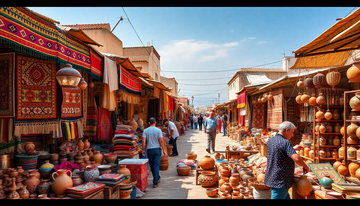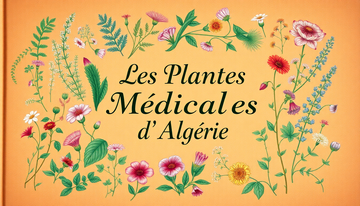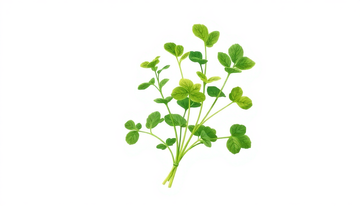Algerian craftsmanship is a true cultural treasure, reflecting the richness and diversity of the country's ancestral traditions. At the heart of this heritage lies the use of local materials, which plays a crucial role in preserving the identity and authenticity of artisanal products.
Local Materials Used in Algerian Craftsmanship
Algeria is rich in natural resources that have shaped traditional artisanal techniques. Among the most commonly used materials are:
Raw Earth and Adobe
Raw earth, in the form of mud bricks or adobe, has long been the preferred material for building traditional homes in Algeria. This ancient technique, still prevalent in some regions, is also used in the production of pottery, tiles, and other everyday objects.
Natural Stone
Algeria boasts a rich mineral heritage, with numerous quarries of natural stones such as limestone, sandstone, and marble. These materials are widely used in construction, as well as in the creation of sculptures, fountains, and other decorative elements.
Local Wood
Despite extensive exploitation of Algerian forests, local wood species such as oak, cedar, and olive are still used in the production of furniture, utility objects, and traditional musical instruments.
Plant Fibers
Plant fibers, such as dwarf palm, rush, or esparto grass, are ancestral materials used in weaving baskets, mats, and rugs. Their use highlights the close relationship between Algerian craftsmanship and its natural environment.
Advantages of Using Local Materials
The use of local materials in Algerian craftsmanship offers numerous advantages:
Preservation of Cultural Heritage
Using these materials roots craftsmanship in the traditions and history of Algeria. This helps pass down ancestral skills and keeps the country's cultural identity alive.
Sustainability and Environmental Respect
Local materials, often natural and biodegradable, are generally more environmentally friendly than industrial materials. Their use contributes to the sustainability of artisanal products and reduces the ecological footprint.
Support for the Local Economy
The exploitation and transformation of local materials generate jobs and income for artisan communities, thereby promoting local economic development.
Authenticity of Craft Products
The use of local materials gives artisanal products authenticity and uniqueness, setting them apart from mass-produced industrial items.
Traditional Craft Techniques
Algerian craftsmanship is characterized by a great diversity of techniques, closely linked to the use of local materials:
Pottery
Traditional Algerian pottery, hand-shaped from local clay, is distinguished by its forms, patterns, and colors characteristic of each region.
Woodworking
Woodworking, especially in the creation of furniture, decorative objects, and musical instruments, showcases local wood species and ancestral skills.
Weaving and Embroidery
The weaving of carpets, tapestries, and traditional garments, as well as embroidery, often uses local plant fibers such as dwarf palm or esparto grass.
Berber Jewelry
Berber jewelry, made from precious metals and semi-precious stones, demonstrates the ingenuity and creativity of Algerian artisans.
Challenges Facing Algerian Craftsmanship
Despite the many advantages of using local materials, Algerian craftsmanship faces several challenges in the context of globalization and competition from industrial products.
Competition from Industrial Products
The rise of industrial products, often cheaper, pressures local artisans who struggle to maintain the competitiveness of their creations.
Transmission of Skills
Passing down ancestral artisanal techniques to new generations is a major challenge, given the appeal of jobs in more modern sectors.
Adapting to New Trends
Artisans must also adapt to changing tastes and trends while preserving the authenticity of their products.
Initiatives to Promote Local Materials
Various initiatives are being implemented to promote the use of local materials in Algerian craftsmanship:
Government Programs
Algerian authorities have established support programs for craftsmanship, including training, subsidies, and the creation of artisanal zones.
Artisanal Cooperatives
Artisanal cooperatives play a crucial role in promoting local products by facilitating access to raw materials and organizing marketing.
Training and Workshops
Numerous training sessions and workshops are offered to pass down traditional artisanal techniques and encourage the use of local materials.
Algerian Craftsmanship and Sustainable Development
The use of local materials in Algerian craftsmanship also aligns with sustainable development practices:
Circular Economy
Artisans often value waste and by-products, contributing to a more circular and environmentally friendly economy.
Reducing Carbon Footprint
Using local materials, often natural and biodegradable, helps reduce the carbon footprint associated with the transport and processing of raw materials.
Waste Valorization
Some artisans develop innovative techniques to recycle and reuse waste, contributing to waste reduction and the preservation of natural resources.
Conclusion
The use of local materials in Algerian craftsmanship is essential for preserving the country's cultural heritage and identity. These materials, derived from the natural environment, give artisanal products unique authenticity and durability. Faced with the challenges of globalization, initiatives to promote the use of these local materials are crucial to ensuring the sustainability of Algerian craftsmanship and its role in the sustainable development of Algeria.






